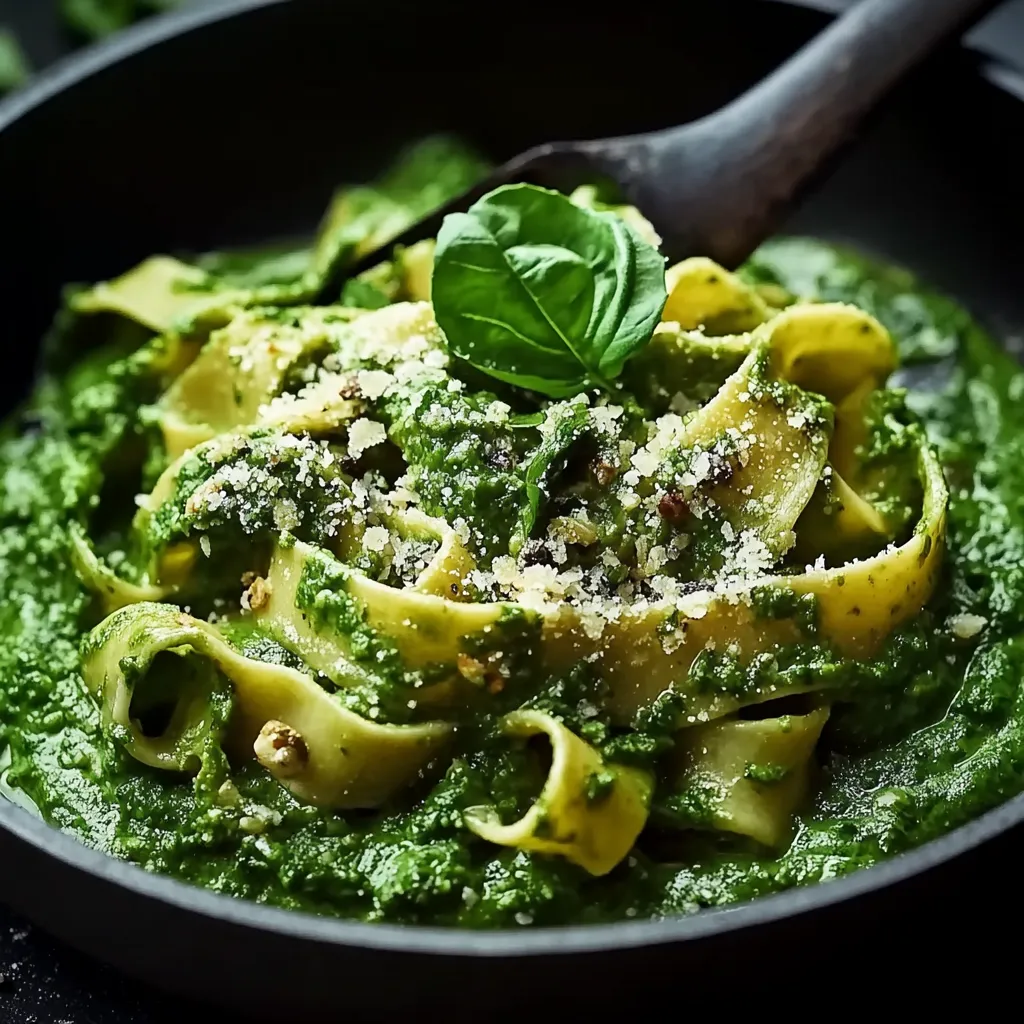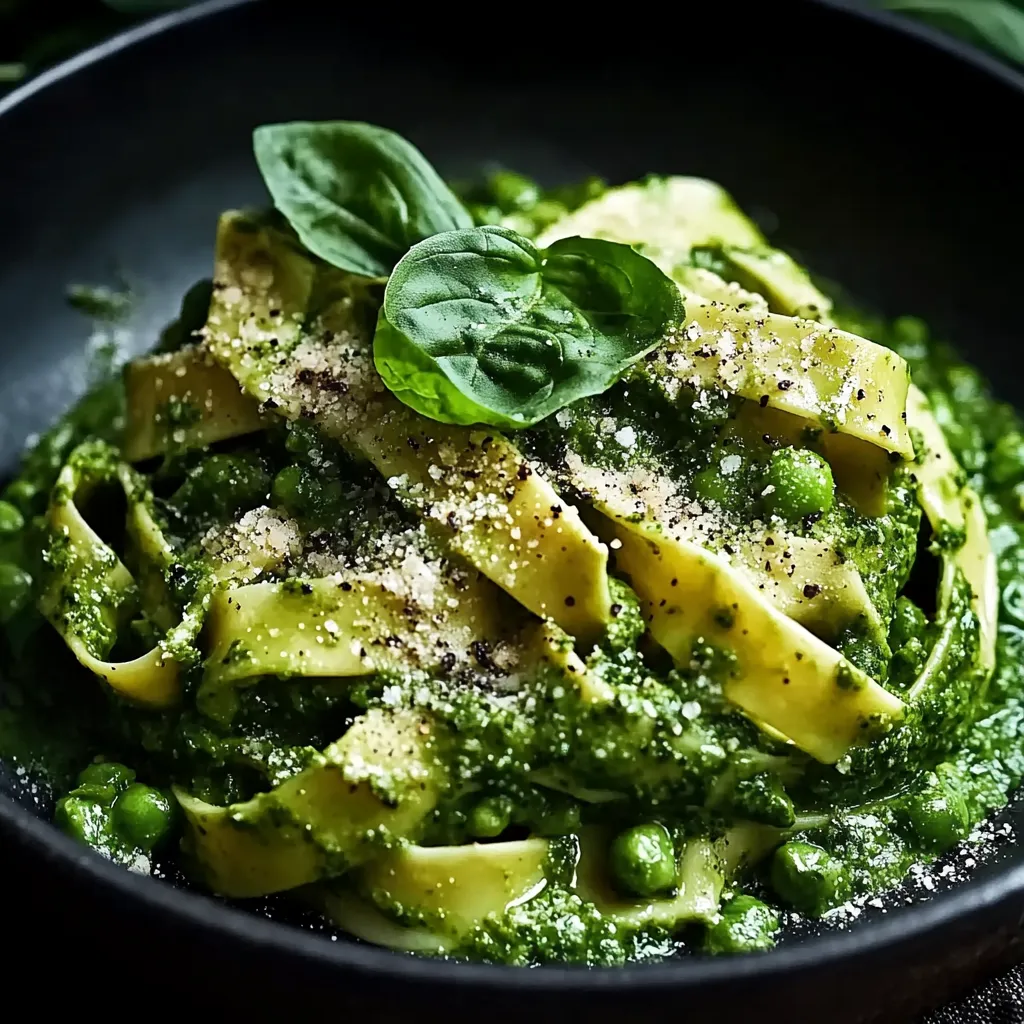 Pin it
Pin it
This fettuccine with creamy spinach sauce transforms simple ingredients into a vibrant green pasta dish that looks as beautiful as it tastes. The velvety spinach sauce coats each strand of pasta while fresh asparagus and sweet peas add texture and brightness to every bite.
I created this recipe during springtime when my garden was overflowing with spinach, and I needed creative ways to use it. What started as a kitchen experiment has become our family's most requested pasta dish, especially during the transitional seasons when we crave something both comforting and fresh.
Ingredients
- Fettuccine pasta: Serves as the perfect vehicle for capturing the silky sauce in its flat, ribbon shape
- Fresh spinach: Forms the foundation of our vibrant green sauce while adding nutrients and mild flavor
- Heavy cream: Creates the luxurious texture that makes this sauce irresistible; look for high-quality full-fat cream
- Parmesan cheese: Adds savory depth and helps thicken the sauce; aged Parmigiano Reggiano offers the best flavor
- Fresh garlic: Provides essential aromatic foundation; use fresh cloves rather than pre-minced for best results
- Green asparagus: Adds texture and earthy sweetness; choose bright stalks with tightly closed tips
- Green peas: Bring natural sweetness and pop of texture; fresh spring peas are amazing, but frozen work perfectly
- Pine nuts: Contribute buttery notes and pleasant crunch; toast them lightly to enhance their flavor
- Fresh basil: Brightens the entire dish with its aromatic finish; pick vibrant leaves without dark spots
Step-by-Step Instructions
- Cook the Pasta:
- Fill a large pot with water (about 4 quarts) and add 1 tablespoon salt. Bring to a rolling boil before adding fettuccine. Cook for exactly the time suggested on package for al dente pasta, usually 9-11 minutes. Stir occasionally to prevent sticking. Before draining, scoop out ½ cup of the starchy pasta water, a crucial step that will help our sauce adhere to the pasta. Drain pasta but do not rinse, as the starch helps the sauce cling to each strand.
- Create the Flavorful Base:
- Warm olive oil in a large skillet over medium heat until it shimmers but doesn't smoke. Add minced garlic and cook for precisely 60 seconds, stirring constantly to prevent burning. You want the garlic fragrant but not brown, as burnt garlic will make the entire sauce bitter. Add the chopped spinach in batches, allowing each handful to wilt slightly before adding more. The volume will reduce dramatically. Cook until all spinach is bright green and completely wilted, approximately 2-3 minutes.
- Blend the Silky Sauce:
- Transfer the cooked spinach mixture to a blender or food processor. Add the heavy cream, freshly grated Parmesan, salt, pepper, and that crucial pinch of nutmeg (which enhances the cream without being detectable). Add fresh lemon juice to brighten all flavors. Blend on high speed for 60-90 seconds until completely smooth with no visible spinach pieces. The sauce should be vibrant green and have the consistency of heavy cream.
- Prepare the Spring Vegetables:
- Bring 2 cups of water to a boil in a wide pan. Add asparagus pieces and cook for exactly 2 minutes—they should be bright green but still crisp. Add peas and cook one minute more. Immediately drain and plunge into ice water to preserve their vibrant color and stop the cooking process. Drain again once cooled. This blanching technique ensures perfectly cooked vegetables that maintain their integrity.
- Combine and Finish:
- Return the blended spinach sauce to the skillet over low heat. Add the blanched vegetables and warm for 2 minutes. Add the drained fettuccine directly to the sauce, tossing gently with tongs to coat every strand. If the sauce seems too thick, add splashes of reserved pasta water until you reach desired consistency. Cook for 1-2 minutes more, allowing the pasta to absorb some of the sauce and flavors to meld together.
 Pin it
Pin it
My absolute favorite part of this recipe is the moment the spinach sauce comes together in the blender. The transformation from simple wilted greens to a luxurious, velvety sauce never fails to delight me. My daughter calls it "princess pasta" because of its beautiful green color, and watching her devour vegetables without complaint is its own special kind of kitchen magic.
Make It Dairy-Free
This pasta dish converts beautifully to a vegan version without sacrificing creaminess. Replace heavy cream with full-fat coconut milk for richness or cashew cream for a neutral base. Use nutritional yeast instead of Parmesan to maintain that savory umami quality. The coconut milk version has a subtle sweetness that pairs wonderfully with the spring vegetables. I've served this to guests who couldn't believe it contained no dairy.
Storage and Reheating
Store leftovers in an airtight container in the refrigerator for up to three days. The sauce may thicken considerably when chilled. When reheating, add a splash of water or broth to loosen the sauce, and warm gently over medium-low heat, stirring frequently to prevent scorching. Avoid microwave reheating if possible as it can cause the sauce to separate. For best results, refresh with a squeeze of fresh lemon juice and additional herbs after reheating.
Seasonal Variations
Adapt this versatile recipe throughout the year by swapping vegetables based on seasonal availability. In summer, replace asparagus with zucchini ribbons and peas with cherry tomatoes. Fall calls for roasted butternut squash cubes and crispy sage leaves. Winter versions shine with roasted mushrooms and caramelized onions. The spinach sauce remains your constant base while the accompaniments change with the seasons, creating a year-round staple that never feels repetitive.
 Pin it
Pin it
This delicious pasta is sure to become a family favorite with its vibrant flavors and creamy texture!
Frequently Asked Questions
- → Can I make this dish dairy-free?
Yes! Simply substitute the heavy cream with full-fat coconut milk and replace the Parmesan cheese with nutritional yeast. The coconut milk provides similar creaminess, while nutritional yeast offers a cheesy flavor. The dish will maintain its silky texture and rich taste while being completely dairy-free.
- → How can I prep the components ahead of time?
You can blanch the asparagus and peas up to a day ahead and refrigerate them. The spinach sauce can also be made up to 2 days in advance and stored in an airtight container in the refrigerator. When ready to serve, cook the pasta fresh, reheat the sauce gently, add the vegetables, and toss everything together.
- → Can I use frozen spinach instead of fresh?
Yes, frozen spinach works well as a substitute. Thaw and thoroughly drain about 10 ounces of frozen spinach (equivalent to 4 cups fresh), squeezing out excess moisture. Skip the wilting step and add it directly to the sautéed garlic before blending the sauce.
- → What can I substitute for pine nuts?
Pine nuts can be expensive, so feel free to substitute with toasted slivered almonds as mentioned in the recipe. Other excellent alternatives include chopped walnuts, pistachios, or even toasted breadcrumbs for a different type of crunch and flavor profile.
- → What sides pair well with this pasta dish?
This fettuccine works beautifully with a simple side salad dressed with lemon vinaigrette. Garlic bread or focaccia makes an excellent accompaniment for soaking up extra sauce. For a more substantial meal, add grilled chicken or salmon on the side, or mix directly into the pasta.
- → How do I prevent the sauce from separating when reheating leftovers?
When reheating leftovers, warm them slowly over low heat, stirring gently. Add a splash of cream or reserved pasta water to bring the sauce back to its silky consistency. Avoid using the microwave on high power, as this can cause the sauce to separate.
